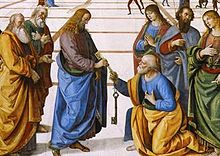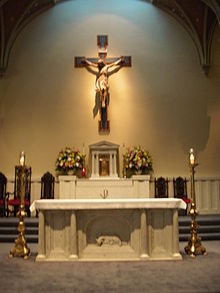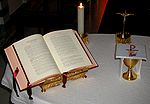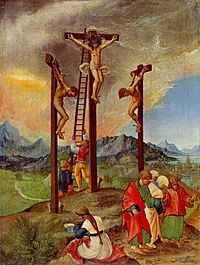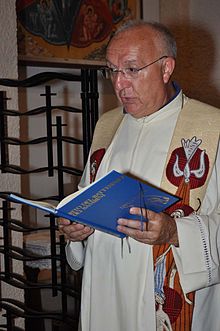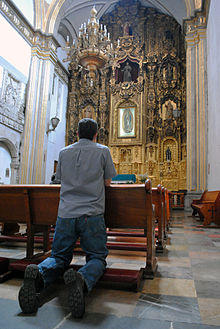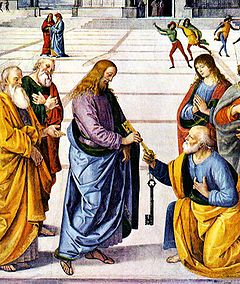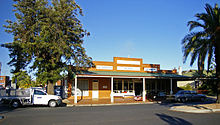
Catholic Church
About this schools Wikipedia selection
SOS Children made this Wikipedia selection alongside other schools resources. A quick link for child sponsorship is http://www.sponsor-a-child.org.uk/
The Catholic Church, also known as the Roman Catholic Church, is the world's largest Christian church, with 1.2 billion members worldwide. It is among the oldest institutions in the world and has played a prominent role in the history of Western civilisation. The Catholic hierarchy is led by the Pope and includes cardinals, patriarchs and diocesan bishops. The Church teaches that it is the one true church divinely founded by Jesus Christ, that its bishops are the successors of Christ's apostles and that the Pope is the sole successor to Saint Peter who has apostolic primacy.
The Church maintains that the doctrine on faith and morals that it presents as definitive is infallible. There are a variety of doctrinal and theological emphases within the Catholic Church, including the Eastern Catholic Churches, the personal ordinariates and religious communities such as the Jesuits, the Franciscans and the Dominicans.
The Catholic Church is Trinitarian and defines its mission as spreading the Gospel of Jesus Christ, administering the sacraments and exercising charity. Catholic worship is highly liturgical, focusing on the Mass or Divine Liturgy during which the sacrament of the Eucharist is celebrated. The Church teaches that bread and wine used during the Mass become the body and blood of Christ through transubstantiation. The Catholic Church practises closed communion and only baptised members of the Church in a state of grace are ordinarily permitted to receive the Eucharist.
Catholic social teaching emphasises support for the sick, the poor and the afflicted through the corporal works of mercy. The Catholic Church is the largest non-government provider of education and medical services in the world. Catholic spiritual teaching emphasises spread of the Gospel message and growth in spiritual discipline through the spiritual works of mercy.
The Church holds the Blessed Virgin Mary, as mother of Jesus Christ, in special regard and has defined four specific Marian dogmatic teachings, namely her Immaculate Conception without original sin, her status as the Mother of God, her perpetual virginity and her bodily Assumption into Heaven at the end of her earthly life. Numerous Marian devotions are also practised.
Name
The term " catholic" is derived from the Greek word καθολικός (katholikos) meaning "universal" and was first used to describe the Church in the early 2nd century. The term katholikos is equivalent to καθόλου (katholou), a contraction of the phrase καθ' ὅλου (kath' holou) meaning "according to the whole". "Catholic Church" (he katholike ekklesia) first appears in a letter of St Ignatius written in about 110. In the "Catechetical Discourses" of St. Cyril of Jerusalem, "Catholic Church" is used to distinguish it from other groups that also call themselves the church.
Since the East–West Schism of 1054, the church that remained in communion with the See of Rome continued to call itself "Catholic" while the Eastern churches have generally been known as "Orthodox" or "Eastern Orthodox". Following the Reformation in the 16th century, the Church continued to use the term "Catholic" to distinguish itself from the various Protestant denominations that split off.
The name "Catholic Church" is the most common designation used in official church documents. It is also the term which Paul VI used when signing documents of the Second Vatican Council. However, Church documents produced both by the Holy See and by certain national episcopal conferences occasionally refer to the Roman Catholic Church. The Catechism of Pope Pius X published in 1908 also used the term "Roman" to distinguish the Catholic Church from other Christian communities who are not in full communion with the Church of Rome.
Organisation and demographics
Papacy and Roman Curia

The Church's hierarchy is headed by the Bishop of Rome, the Pope, who is the leader of the worldwide Catholic Church composed of the Latin Church and the Eastern Catholic Churches in full communion with the see of Rome. The current pope is Pope Francis, elected on March 13, 2013 by papal conclave.
The office of the pope is known as the Papacy. His ecclesiastical jurisdiction is called the " Holy See" (Sancta Sedes in Latin), or the " Apostolic See" (meaning the see of the Apostle Saint Peter). Directly serving the Pope is the Roman Curia, the central governing body that administers the day-to-day business of the Catholic Church. The pope is also head of state of Vatican City State, a sovereign city-state entirely enclaved within the city of Rome. The legal entity of the Holy See is distinct from that of the Vatican City state and all foreign relations are accredited to the Holy See.
Following the death or resignation of a pope, members of the College of Cardinals who are under age 80 meet in the Sistine Chapel in Rome to elect a new pope. The position of cardinal is a rank of honour bestowed by popes on certain ecclesiastics, such as leaders within the Roman Curia, bishops serving in major cities and distinguished theologians. Although this election, known as a papal conclave, can theoretically elect any male Catholic as pope, since 1389 only fellow cardinals have been elevated to that position.
For advice and assistance in governing, the Pope may turn to the College of Cardinals, the next highest level in the hierarchy.
Autonomous particular churches
The Catholic Church is made up of 23 autonomous particular churches, each of which accepts the paramountcy of the Bishop of Rome on matters of doctrine. These churches, also known by the Latin term sui iuris churches, are communities of Catholic Christians whose forms of worship reflect different historical and cultural influences rather than differences in doctrine. In general, each sui iuris church is headed by a patriarch or high ranking bishop, and has a degree of self-governance over the particulars of its internal organisation, liturgical rites, liturgical calendar and other aspects of its spirituality.
The largest of the particular churches is the Latin Church which reports over one billion members. It developed in southern Europe and North Africa. Then it spread throughout Western, Central and Northern Europe, before expanding to the rest of the world. The Latin Church considered itself to be the oldest and largest branch of Western Christianity, a heritage of certain beliefs and customs originating in various European countries, some of which are shared also by many Christian denominations that trace their origins to the Protestant Reformation.
Relatively small in terms of adherents compared to the Latin Church, but important to the overall structure of the Church, are the 22 self-governing Eastern Catholic Churches with a membership of 17.3 million as of 2010. The Eastern Catholic Churches follow the traditions and spirituality of Eastern Christianity and are composed of Eastern Christians who have always remained in full communion with the Catholic Church or who have chosen to reenter full communion in the centuries following the East–West Schism and earlier divisions. Some Eastern Catholic Churches are governed by a patriarch who is elected by the synod of the bishops of that church, others are headed by a major archbishop, others are under a metropolitan, and others consist of individual eparchies. The Roman Curia has a specific department, the Congregation for the Oriental Churches, to maintain relations with them.
- Examples of Eastern Catholic Churches can be found in the side bar "Major Sui Iuris Churches".
Dioceses, parishes and religious orders
Individual countries, regions, or major cities are served by local particular Churches known as dioceses or eparchies, each overseen by a Catholic bishop. Each diocese is united with one of the worldwide "sui iuris" particular churches, such as the Latin Church, or one of the many Eastern Catholic Churches. As of 2008, the Catholic Church altogether comprised 2,795 dioceses. The bishops in a particular country or region are often organised into an episcopal conference, which aids in maintaining a uniform style of worship and co-ordination of social justice programmes within the areas served by member bishops.
Dioceses are further divided into numerous individual communities called parishes, each staffed by one or more priests, deacons and/or lay ecclesial ministers. Parishes are responsible for the day to day celebration of the sacraments and pastoral care of the Catholic laity.
Ordained Catholics, as well as members of the laity, may enter into consecrated life either on an individual basis, as a hermit or consecrated virgin, or by joining an institute of consecrated life (a religious institute or a secular institute) in which to take vows confirming their desire to follow the three evangelical counsels of chastity, poverty and obedience. Examples of institutes of consecrated life are the Benedictines, the Carmelites, the Dominicans, the Franciscans, the Missionaries of Charity and the Sisters of Mercy.
Women constitute the majority of members of the consecrated life within the church. In 2006, the number of nuns worldwide had been in decline, but women still constituted around 753,400 members of the consecrated life, of a total worldwide membership of around 945,210. Of these members, 191,810 were men—including around 136,171 priests. Women were engaged in a variety of vocations, from contemplative prayer, to teaching, providing health care and working as missionaries.
Membership statistics
Total church membership (both lay and clerical) in 2007 was 1.147 billion people, having increased from 437 million in 1950 and 654 million in 1970. On 31 December 2011, membership was 1.196 billion, an increase of 11.54% over the same date in 2000, which was only slightly greater than the rate of increase of the world population (10.77%). The increase was 33.02% in Africa, but only 1.17% in Europe. It was 15.91% in Asia, 11.39% in Oceania and 10.93% in the Americas. As a result, Catholics were 17.77% of the total population in Africa, 63.10% in the Americas, 3.05% in Asia, 39.97% in Europe, 26.21% in Oceania and 17.09% of the world population.
Of the world's Catholics, the proportion living in Africa grew from 12.44% in 2000 to 14.84% in 2008, while those living in Europe declined from 26.81% to 24.31%. Membership in the Catholic Church is attained through baptism or reception into the Church (for individuals previously baptised in non-Catholic Christian churches). For some years until 2009, if someone formally left the Church, that fact was noted in the register of the person's baptism.
In 2007, Vatican records listed 408,024 Catholic priests in the world, 762 more than at the beginning of the year. The main growth areas have been Asia and Africa, with 21.1% and 27.6% growth respectively. In North and South America, numbers have remained approximately the same, while there was a 6.8% decline in Europe and a 5.5% decrease in Oceania from 2000 to 2007.
Since the early 2000s the number of practicing Catholics have been reported to be declining in millions throughout the world.
Worship and liturgy
Among the 23 autonomous (sui iuris) churches, numerous forms of worship and liturgical traditions exist, called "rites", which reflect historical and cultural diversity rather than differences in belief. In the definition of the Code of Canons of the Eastern Churches, "a rite is the liturgical, theological, spiritual, and disciplinary patrimony, culture and circumstances of history of a distinct people, by which its own manner of living the faith is manifested in each Church sui iuris", but the term is often limited to liturgical patrimony. The most commonly used liturgy is the Roman Rite in its ordinary form, but other rites are in use in the Eastern Catholic Churches and even in the Latin Church.
Celebration of the Eucharist
In all rites the Mass, or Divine Liturgy, is the centre of Catholic worship. The Catholic Church teaches that at each Mass the bread and wine become the body and blood of Christ by the words of consecration spoken by the priest. The Church teaches that this happens through transubstantiation, in which the "accidents" (perceptible aspects) of the sacramental bread and wine remain, but the underlying substance is transmuted into the body, blood, soul and divinity of Christ, and is not merely symbolic. The words of consecration are drawn from the three synoptic Gospels and a Pauline letter. The Church teaches that Christ established a New Covenant with humanity through the institution of the Eucharist at the Last Supper, as described in these biblical verses.
Hoc est enim corpus meum...
Because the Church teaches that Christ is present in the Eucharist, there are strict rules about who may celebrate and who may receive the Eucharist in the Catholic Church. The sacrament can only be celebrated by an ordained Catholic priest. Those who are conscious of being in a state of mortal sin are forbidden to receive the sacrament until they have received absolution through the sacrament of Reconciliation (Penance). Catholics are normally obliged to abstain from eating for at least an hour before receiving the sacrament.
Catholics, even if they were in danger of death and unable to approach a Catholic minister, may not ask for the sacraments of the Eucharist, penance or anointing of the sick from someone, such as a Protestant minister, who is not known to be validly ordained in line with Catholic teaching on ordination. Likewise, even in grave and pressing need, Catholic ministers may not administer these sacraments to those who do not manifest Catholic faith in the sacrament. In relation to the churches of Eastern Christianity not in communion with the Holy See, the Catholic Church is less restrictive, declaring that "a certain communion in sacris, and so in the Eucharist, given suitable circumstances and the approval of Church authority, is not merely possible but is encouraged."
Western liturgical rites
| Catholic Church |
|---|
| Structure of the Roman Rite Mass Roman Missal, chalice (with purificator, |
| A. Introductory rites |
|
| B. Liturgy of the Word |
|
| C. Liturgy of the Eucharist |
|
| D. Concluding rites |
| Source: General Instruction of the Roman Missal Catholicism Portal |
The Roman Rite is the most common rite of worship used by the Catholic Church. Its use is found worldwide, spread by missionary activity originating in European Catholic nations throughout Christian history.
Two forms of the Roman Rite are authorised at present. The generally used ordinary form, celebrated mostly in the vernacular, is that of the post-1969 editions of the Roman Missal, and is known as the Mass of Paul VI. The extraordinary form, celebrated only in Latin, is that of the edition of 1962, the year of the opening of the Second Vatican Council, and is known as the Tridentine Mass. An outline of the major liturgical elements of Roman Rite Mass can be found in the side bar.
In the United States, "Anglican Use" parishes have been created. They use a variation of the Roman rite that retains some of the wording of the Anglican liturgical rites. Implementation is expected of the authorisation granted in 2009 for the creation wherever appropriate of ordinariates for groups of Anglicans who have been approved for entrance into the Catholic Church and who may in the future use a rite that incorporates elements of Anglican tradition. Other Western liturgical rites (non-Roman) include the Ambrosian Rite and the Mozarabic Rite.
Eastern liturgical rites
The liturgical rites of the Eastern Catholic Churches are very similar to, and often identical with, the rites used by the Eastern Orthodox and other Eastern Christian churches which historically developed in Russia, Caucasus and the Balkans, North Eastern Africa and the Middle East, but are no longer in communion with the Bishop of Rome, the Pope. The Eastern Catholic Churches are either groups of faithful which have restored full communion with the Bishop of Rome, while preserving their identity as Eastern Christians, or groups with which full communion has never been broken.
The rites used by the Eastern Catholic Churches include the Byzantine Rite, in its Antiochian, Greek and Slavonic varieties, the Alexandrian Rite, the Syriac Rite, the Armenian Rite, the Maronite Rite and the Chaldean Rite. In the past some of the rites used by the Eastern Catholic Churches were subject to some degree of liturgical Latinisation. However, in recent years Eastern Catholic Churches have returned to traditional Eastern practices in accord with the Vatican II decree Orientalium Ecclesiarum. Each church has its own liturgical calendar.
Doctrine
The fundamental beliefs of the Christian religion are summarised in the Nicene Creed. For Catholics, they are detailed in the Catechism of the Catholic Church. Based on the promises of Christ in the Gospels, the Church believes that it is continually guided by the Holy Spirit and so protected infallibly from falling into doctrinal error. The Catholic Church teaches that the Holy Spirit reveals God's truth through Sacred scripture, Sacred tradition and the Magisterium.
Sacred Scripture consists of the 73 book Catholic Bible. This is made up of the 46 books found in the ancient Greek version of the Old Testament—known as the Septuagint—and the 27 New Testament writings first found in the Codex Vaticanus Graecus 1209 and listed in Athanasius' Thirty-Ninth Festal Letter. Sacred Tradition consists of those teachings believed by the Church to have been handed down since the time of the Apostles. Sacred Scripture and Sacred Tradition are collectively known as the "deposit of faith" (depositum fidei). These are in turn interpreted by the Magisterium (from magister, Latin for "teacher"), the Church's teaching authority, which is exercised by the Pope and the College of Bishops in union with the Pope, the bishop of Rome.
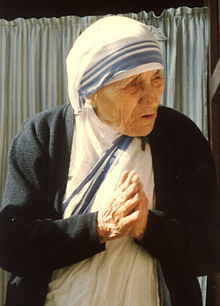
Catholic social teaching
The social Gospel espoused by Jesus and Catholic social teaching place a heavy emphasis on the corporal works of mercy and the spiritual works of mercy, namely the support and concern for the sick, the poor and the afflicted. Church teaching calls for a preferential option for the poor while canon law prescribes that "The Christian faithful are also obliged to promote social justice and, mindful of the precept of the Lord, to assist the poor."
The Church enumerates "corporal works of mercy" and "spiritual works of mercy" as follows:
| Corporal Works of Mercy | Spiritual Works of Mercy |
|---|---|
| 1. To feed the hungry. | 1. To instruct the ignorant. |
| 2. To give drink to the thirsty. | 2. To counsel the doubtful |
| 3. To clothe the naked. | 3. To admonish sinners. |
| 4. To harbour the harbourless (shelter the homeless). | 4. To bear wrongs patiently. |
| 5. To visit the sick. | 5. To forgive offences willingly. |
| 6. To ransom the captive. | 6. To comfort the afflicted. |
| 7. To bury the dead. | 7. To pray for both the living and the dead. |
The Catholic Church is the largest provider of health services in the world. In 2010, the Catholic Church's Pontifical Council for Pastoral Assistance to Health Care Workers said that the Church manages 26% of health care facilities in the world, including hospitals, clinics, orphanages, pharmacies and centres for those with leprosy.
Religious institutes for women have played a particularly prominent role in the provision of health and education services, as with orders such as the Sisters of Mercy, Little Sisters of the Poor, the Missionaries of Charity, the Sisters of St. Joseph of the Sacred Heart, the Sisters of the Blessed Sacrament and the Daughters of Charity of Saint Vincent de Paul.
The Church is also actively engaged in international aid and development through organisations such as Catholic Relief Services, Caritas International, Aid to the Church in Need, refugee advocacy groups such as the Jesuit Refugee Service and community aid groups such as the Saint Vincent de Paul Society.
Trinity
The Catholic Church holds that there is one eternal God, who exists as a mutual indwelling of three persons: God the Father; God the Son; and God the Holy Spirit, which make up the Trinity.
Catholics believe that Jesus Christ is the second person of the Trinity, God the Son. In an event known as the Incarnation, through the power of the Holy Spirit, God became united with human nature through the conception of Christ in the womb of the Blessed Virgin Mary. Christ therefore is both fully divine and fully human. It is taught that Christ's mission on earth included giving people his teachings and providing his example for them to follow as recorded in the four Gospels.
The Church teaches that through the passion (suffering) of Christ and his crucifixion as described in the Gospels, all people have an opportunity for forgiveness and freedom from sin and so can be reconciled to God. The Resurrection of Jesus gained for humans a possible spiritual immortality previously denied to them because of original sin. By reconciling with God and following Christ's words and deeds, an individual can enter the Kingdom of God, which is the "... reign of God over people's hearts and lives".
The Greek term "Christ" and the Hebrew "Messiah" both mean "anointed one", referring to the Christian belief that Jesus' death and resurrection are the fulfilment of the Old Testament's messianic prophecies.
Apostolicity
According to the Catechism, the Catholic Church professes to be the "sole Church of Christ", which is described in the Nicene Creed as the one, holy, catholic, and apostolic Church. The church teaches that its founder is Jesus Christ, who appointed the twelve Apostles to continue his work as the Church's earliest bishops. Catholic belief holds that the Church "is the continuing presence of Jesus on earth", and that all duly consecrated bishops have a lineal succession from the apostles. In particular, the Bishop of Rome (the Pope), is considered the successor to the apostle Simon Peter, from whom the Pope derives his supremacy over the Church. The Church is further described in the papal encyclical Mystici Corporis Christi as the Mystical Body of Christ.
The Church teaches that the fullness of the "means of salvation" exists only in the Catholic Church, but the Church acknowledges that the Holy Spirit can make use of Christian communities separated from itself to "impel towards Catholic unity" and thus bring people to salvation. It teaches that anyone who is saved is saved through the Church but that people can be saved ex voto and by pre-baptismal martyrdom as well as when conditions of invincible ignorance are present, although invincible ignorance in itself is not a means of salvation.
Sacraments
According to the Council of Trent, Christ instituted seven sacraments and entrusted them to the Church. These are Baptism, Confirmation, the Eucharist, Reconciliation ( Penance), Anointing of the Sick (formerly called Extreme Unction, one of the " Last Rites"), Holy Orders and Holy Matrimony. Sacraments are visible rituals that Catholics see as signs of God's presence and effective channels of God's grace to all those who receive them with the proper disposition ( ex opere operato). The Catechism of the Catholic Church categorises the sacraments into three groups, the "sacraments of Christian initiation", "sacraments of healing" and "sacraments at the service of communion and the mission of the faithful". These groups broadly reflect the stages of people's natural and spiritual lives which each sacrament is intended to serve.
Sacraments of Christian initiation
Baptism
As viewed by the Catholic Church, Baptism is the first of three sacraments of initiation as a Christian. It washes away all sins, both original sin and personal actual sins. It makes a person a member of the Church. As a gratuitous gift of God that requires no merit on the part of the person who is baptised, it is conferred even on children, who, though they have no personal sins, need it on account of original sin. If a new-born child is in a danger of death, anyone—be it a doctor, a nurse, or a parent—may baptise the child. Baptism marks a person permanently and cannot be repeated. The Catholic Church recognises as valid baptisms conferred even by people who are not Catholics or Christians, provided that they intend to baptise ("to do what the Church does when she baptises") and that they use the Trinitarian baptismal formula.

Confirmation
The Catholic Church sees the sacrament of confirmation as required to complete the grace given in baptism. When adults are baptised, confirmation is normally given immediately afterwards, a practice followed even for infants in the Eastern Catholic Church. In the West confirmation of children is delayed until they are old enough to understand or even until they are in their teens. In Western Christianity, particularly Catholicism, the sacrament is called confirmation, because it confirms and strengthens the grace of baptism; in the Eastern Church, it is called chrismation, because the essential rite is the anointing of the person with chrism, a mixture of olive oil and some perfumed substance, usually balsam, blessed by a bishop. Those who receive confirmation must be in a state of grace, which for those who have reached the age of reason means that they should first be cleansed spiritually by the sacrament of Penance; they should also have the intention of receiving the sacrament, and be prepared to show in their lives that they are Christians.
Eucharist
For Catholics, the Eucharist is the sacrament which completes Christian initiation. It is the perpetuation of the sacrifice of Jesus on the cross, and a banquet in which Christ himself is consumed. The Eucharistic sacrifice always includes prayers, readings from the Bible, consecration of wheat bread and grape wine and communion by at least some of the participants (in particular the priest) in the consecrated elements, which by the consecration become, in a way surpassing understanding, the body and blood of Jesus Christ, a change known as transubstantiation. The ceremony in which a Catholic first receives the Eucharist is known as First Communion.
Sacraments of healing
The two sacraments of healing are the Sacrament of Penance and Anointing of the Sick.
Penance
The Sacrament of Penance (also called Reconciliation, Forgiveness, Confession, and Conversion) exists for the conversion of those who, after baptism, separate themselves from Christ by sin. Essential to this sacrament are acts both by the sinner (examination of conscience, contrition with a determination not to sin again, confession to a priest, and performance of some act to repair the damage caused by sin) and by the priest (determination of the act of reparation to be performed and absolution). Serious sins ( mortal sins) must be confessed within at most a year and always before receiving Holy Communion, while confession of venial sins also is recommended. The priest is bound under the severest penalties to maintain the " seal of confession", absolute secrecy about any sins revealed to him in confession.
Anointing of the Sick
While chrism is used only for the three sacraments that cannot be repeated (baptism, confirmation, ordination), a different oil is used by a priest or bishop to bless a Catholic who, because of illness or old age, has begun to be in danger of death. This sacrament, known as Anointing of the Sick, is believed to give comfort, peace, courage and, if the sick person is unable to make a confession, even forgiveness of sins. Although it is not reserved for those in proximate danger of death, it is often administered as one of the Last Rites.
Sacraments at the service of communion
According to the Catechism of the Catholic Church there are two sacraments of communion directed towards the salvation of others: priesthood and marriage. Within the general vocation to be a Christian, these two sacraments consecrate to specific mission or vocation among the people of God. Men receive the holy orders to feed the Church by the word and grace. Spouses marry so that their love may be fortified to fulfil duties of their state.
Ordination
Holy Orders is a sacrament in three degrees or orders, episcopate (bishops), presbyterate (priests) and diaconate (deacons), which consecrates and deputes some Christians to serve the whole body by these specific titles. The Church has defined rules on who may be ordained into the clergy. In the Latin Rite, the priesthood and diaconate are generally restricted to celibate men. Men who are already married may be ordained in the Eastern Catholic Churches in most countries, and the personal ordinariates and may become deacons even in the Western Church (see Clerical marriage). But after becoming a Roman Catholic priest, a man may not marry (see Clerical celibacy) unless he is later formally laicised.
All clergy, whether deacons, priests or bishops, may preach, teach, baptise, witness marriages and conduct funeral liturgies. Only bishops and priests can administer the sacraments of the Eucharist, Reconciliation (Penance) and Anointing of the Sick. Only bishops can administer the sacrament of Holy Orders, which ordains someone into the clergy.
Matrimony
Marriage, understood as an indissoluble union between a man and a woman, if entered into validly by any baptised man and baptised woman, is considered a sacrament by the Catholic Church. The church does not recognise divorce as ending a valid marriage and allows state recognised divorce only as a means of protecting children or property, without allowing remarriage following such a divorce. Apart from the requirements, such as freedom of consent, that it sees as applicable to all, the church has established certain specific requirements for the validity of marriages by Catholics. Failure to observe the Church's regulations, as well as defects applicable to all marriages, may be grounds for a church declaration of the invalidity of a marriage, a declaration usually referred to as an annulment.
Judgement after death
The Church teaches that, immediately after death, the soul of each person will receive a particular judgement from God. This teaching also attests to another day when Christ will sit in a universal judgement of all mankind. This final judgement, according to Church teaching, will bring an end to human history and mark the beginning of a new and better heaven and earth ruled by God in righteousness. The basis on which each person's soul is judged is detailed in the Gospel of Matthew, which lists works of mercy to be performed even to people considered "the least of Christ's brothers". Emphasis is upon Christ's words that "Not everyone who says to me, 'Lord, Lord,' shall enter the kingdom of heaven, but he who does the will of my Father who is in heaven".
According to the Catechism, "The Last Judgement will reveal even to its furthest consequences the good each person has done or failed to do during his earthly life." Depending on the judgement rendered, a soul may enter one of three states of afterlife:
- Heaven is a time of glorious union with God and a life of unspeakable joy that lasts forever.
- Purgatory is a temporary condition for the purification of souls who, although saved, are not free enough from sin to enter directly into heaven. Souls in purgatory may be aided in reaching heaven by the prayers of the faithful on earth and by the intercession of saints.
- Final Damnation: Finally, those who persist in living in a state of mortal sin and do not repent before death subject themselves to hell, an everlasting separation from God. The Church teaches that no one is condemned to hell without having freely decided to reject God. No one is predestined to hell and no one can determine whether anyone else has been condemned. Catholicism teaches that through God's mercy a person can repent at any point before death and be saved. Some Catholic theologians have speculated that the souls of unbaptised infants who die in original sin are assigned to limbo although this is not an official doctrine of the Church.
Virgin Mary
Devotions to Mary are part of Catholic piety but are distinct from the worship of God. The Church holds Mary, as Perpetual Virgin and Mother of God, in special regard. Catholic beliefs concerning Mary include her Immaculate Conception without the stain of original sin and bodily assumption into heaven at the end of her life, both of which have been infallibly defined as dogma, by Pope Pius IX in 1854 and Pope Pius XII in 1950 respectively.
Mariology deals not only with her life but also her veneration in daily life, prayer and Marian art, music and architecture. Several liturgical Marian feasts are celebrated throughout the Church Year and she is honoured with many titles such as Queen of Heaven. Pope Paul VI called her Mother of the Church because, by giving birth to Christ, she is considered to be the spiritual mother to each member of the Body of Christ. Because of her influential role in the life of Jesus, prayers and devotions such as the Hail Mary, the Rosary, the Salve Regina and the Memorare are common Catholic practices.
The Church has affirmed certain Marian apparitions, such as at Lourdes, Fátima, and Guadalupe. Pilgrimages to these sites are popular Catholic devotions.
History
Apostolic period
Catholic tradition and doctrine hold that the Catholic Church was founded by Jesus Christ in the 1st century AD in Judea within the Roman Empire. The New Testament records Jesus' activities and teaching, his appointment of the twelve Apostles and his instructions to them to continue his work.
The Catholic Church teaches that the coming of the Holy Spirit upon the apostles, in an event known as Pentecost, signalled the beginning of the public ministry of the Catholic Church. Catholic doctrine teaches that the contemporary Catholic Church is the continuation of this early Christian community. It interprets the Confession of Peter found in the Gospel of Matthew as Christ's designation of Saint Peter the Apostle and his successors, the Bishops of Rome to be the temporal head of his Church, a doctrine known as apostolic succession.
Spread throughout the Roman Empire
Conditions in the Roman Empire facilitated the spread of new ideas. The empire's well-defined network of roads and waterways allowed for easier travel, while the Pax Romana made it safe to travel from one region to another. The government had encouraged inhabitants, especially those in urban areas, to learn Greek as the common language, which allowed ideas to be more easily expressed and understood. Unlike most religions in the Roman Empire, however, Christianity required its adherents to renounce all other gods, a practice adopted from Judaism (see Idolatry). The Christians' refusal to join pagan celebrations meant they were unable to participate in much of public life, which caused non-Christians—including government authorities—to fear that the Christians were angering the gods and thereby threatening the peace and prosperity of the Empire. The resulting persecutions were a defining feature of Christian self-understanding until Christianity was legalised in the 4th century.
In 313, the struggles of the Early Church were lessened by the legalisation of Christianity by the Emperor Constantine I. In 380, Christianity became the state church of the Roman Empire by the decree of the Emperor, which would persist until the fall of the Western Roman Empire and, later, with the Eastern Roman Empire until the Fall of Constantinople. During this time (the period of the Seven Ecumenical Councils) there were considered five primary sees according to Eusebius: Rome, Constantinople, Antioch, Jerusalem and Alexandria, known as the Pentarchy.
Late Antiquity
In the centuries after the destruction of the Western Roman Empire, Western Christianity was a major factor in the preservation of classical civilisation, especially classical art and literacy (see Illuminated manuscript). Through his Rule, Benedict of Nursia (c.480–543), the founder of Western monasticism exerted an enormous influence on European culture through the appropriation of the monastic spiritual heritage of the early Church and, with the spread of the Benedictine tradition, through the preservation and transmission of ancient culture. During this period, monastic Ireland became a centre of learning and early Irish missionaries such as St Columbanus and St Columba spread Christianity and established monasteries across continental Europe.
In Eastern Christianity, the Byzantine Empire preserved Orthodoxy well after the massive invasions of Islam in the mid-7th century. The invasions of Islam devastated three of the five Patriarchal sees, capturing Jerusalem first, then Alexandria and then, finally, in the mid-8th century, Antioch. The whole period of the next five centuries was dominated by the struggle between Christianity and Islam throughout the Mediterranean Basin. The battles of Poitiers and Toulouse preserved the Catholic tradition even though Rome itself was ravaged in 850 and Constantinople was besieged.
Medieval, Renaissance and Baroque periods
The Catholic Church was the dominant influence on Western civilisation from late antiquity to the dawn of the modern age. It was the primary sponsor of Romanesque, Gothic, Renaissance, Mannerist and Baroque styles in art, architecture and music. Renaissance figures such as Raphael, Michelangelo, Leonardo da Vinci, Botticelli, Fra Angelico, Tintoretto, Titian, Bernini and Caravaggio are examples of the numerous visual artists sponsored by the Church.
In the eleventh century, Gregorian Reform led to the Investiture Controversy between the church and the Holy Roman Emperors, over whether secular powers or the church itself had the sole power to appoint bishops and popes. The efforts of Hildebrand of Sovana led to the creation of the College of Cardinals to elect new popes, starting with Pope Alexander II in the papal election of 1061. When Alexander II died, Hildebrand was elected to succeed him, as Pope Gregory VII. The basic election system of the College of Cardinals which Gregory VII helped establish has continued to function into the twenty-first century.
In the early 13th century mendicant orders were founded by Francis of Assisi and Dominic de Guzmán. The studia conventuale and studia generale of the mendicant orders played a large role in the transformation of Church sponsored cathedral schools and palace schools, such as that of Charlemagne at Aachen, into the prominent universities of Europe. Scholastic theologians and philosophers such as the Dominican priest Thomas Aquinas studied and taught at these studia. Aquinas' Summa Theologica was an intellectual milestone in its synthesis of the legacy of Ancient Greek philosophers such as Plato and Aristotle with the content of Christian revelation.
Doctrinal disputes and schisms
In the 11th century, strained relations between the primarily Greek church and the Latin Church separated them in the East–West Schism, partially due to conflicts over papal authority. The Fourth Crusade and the sacking of Constantinople by renegade crusaders proved the final breach. In the 16th century, in response to the Protestant Reformation, the Catholic Church engaged in a process of substantial reform and renewal, known as the Counter-Reformation. In subsequent centuries, Catholicism spread widely across the world despite experiencing a reduction in its hold on European populations due to the growth of religious scepticism during and after the Enlightenment.
In 1854 Pope Pius IX with the support of the overwhelming majority of Roman Catholic bishops, whom he had consulted from 1851 to 1853, proclaimed the dogma of the Immaculate Conception. In 1870, the First Vatican Council affirmed the doctrine of papal infallibility when exercised in specifically defined pronouncements. Controversy over this and other issues resulted in a breakaway movement called the Old Catholic Church.
Second Vatican Council
The Second Vatican Council in the 1960s introduced the most significant changes to Catholic practices since the Council of Trent four centuries before. Initiated by Pope John XXIII, this ecumenical council modernised the practices of the Catholic Church, allowing the Mass to be said in the vernacular (local language) and encouraging "fully conscious, and active participation in liturgical celebrations." It intended to engage the Church more closely with the present world ( aggiornamento), which was described by its advocates as an "opening of the windows". In addition to changes in the liturgy, it led to changes to the Church's approach to ecumenism, and a call to improved relations with non-Christian religions, especially Judaism, in its document Nostra Aetate.
The Council, however, generated significant controversy in implementing its reforms; proponents of the " Spirit of Vatican II" such as Swiss theologian Hans Küng claimed Vatican II had "not gone far enough" to change church policies. Traditionalist Catholics, such as Archbishop Marcel Lefebvre, however, strongly criticised the council, arguing that the council's liturgical reforms led "to the destruction of the Holy Sacrifice of the Mass and the sacraments," among other issues.
New evangelisation
Pope John Paul II sought to evangelise an increasingly secular world. He instituted World Youth Day as a "worldwide encounter with the Pope" for young people which is now held every two to three years. He travelled more than any other pope, visiting 129 countries, and used television and radio as means of spreading the Church's teachings. In 2012, the 50th anniversary of Vatican II, the Church called a new Synod to discuss re-evangelising lapsed Catholics in the developed world.
Contemporary issues
Social justice issues
In 1978, Pope John Paul II, formerly archbishop of Kraków in then-Communist Poland, became the first non-Italian Pope in 455 years. His 27-year pontificate was one of the longest in history. Mikhail Gorbachev, the president of the Soviet Union, credited the Polish pope with hastening the fall of Communism in Europe.
The Catholic nun Mother Teresa of Calcutta was awarded the Nobel Peace Prize in 1979 for her humanitarian work among India's poor. Bishop Carlos Filipe Ximenes Belo won the same award in 1996 for "work towards a just and peaceful solution to the conflict in East Timor".
Sexuality and gender issues
Soon after the close of the Second Vatican Council, Church teachings about sexuality became an issue of increasing controversy due to changing cultural attitudes in the Western world (see the sexual revolution).
The Church teaches that sexual intercourse should only take place between a married man and woman, and should be without the use artificial birth control or contraception. In his encyclical Humanae Vitae (1968), Pope Paul VI firmly rejected all artificial contraception, thus contradicting dissenters in the Church that saw the birth control pill as an ethically justifiable method of contraception, though he permitted the regulation of births by means of natural family planning. This teaching was continued especially by John Paul II in his encyclical Evangelium Vitae, where he clarified the Church's position on contraception, abortion and euthanasia by condemning them as part of a "culture of death" and calling instead for a "culture of life".
The Church teaches that homosexual inclinations are "objectively disordered" and so homosexual behaviour is "contrary to the natural law". The Church teaches that people who have homosexual tendencies are called to live chastely. Because of these teachings, as well as its teaching that marriage is between one man and one woman, the Catholic Church firmly opposes same-sex marriage.
In religious vocations, Catholic women and men are ascribed different roles—men serve as deacons, priests, friars, monks, brothers, abbots or in episcopal positions while women serve as nuns, religious sisters or abbesses. Monks and brothers often house together in monasteries while nuns and sisters may house themselves in convents—though an abbey may host a religious community of men or women. In other roles, the Church does not distinguish between men and women, who may be equally recognised as saints, Doctors of the Church, catechists in schools, altar servers, Extraordinary ministers of Holy Communion at Mass, or as readers (lectors) during the liturgy.
Women constitute the great majority of members of the consecrated life. While Holy Orders are reserved for men, Catholic women have played diverse roles in the life of the church, with religious institutes providing a formal space for their participation and convents providing spaces for their self-government, prayer and influence through many centuries. Religious sisters and nuns have been extensively involved in developing and running the Church's worldwide health and education service networks.
Efforts in support of the ordination of women led to several rulings by the Roman Curia or Popes against the proposal, as in Declaration on the Question of the Admission of Women to the Ministerial Priesthood (1976), Mulieris Dignitatem (1988) and Ordinatio Sacerdotalis (1994). According to the latest ruling, found in Ordinatio Sacerdotalis, Pope John Paul II concluded, "I declare that the Church has no authority whatsoever to confer priestly ordination on women and that this judgment is to be definitively held by all the Church's faithful." In defiance of these rulings, opposition groups such as Roman Catholic Womenpriests have performed alleged ordination ceremonies (with, reputedly, an ordaining male Catholic bishop in the first few instances) which, according to canon law, are both illicit and invalid and considered mere simulations of the sacrament of Ordination. The Congregation for the Doctrine of the Faith responded by issuing a statement clarifying that any Catholic bishops involved in ordination ceremonies for women, as well as the women themselves if they were Catholic, would automatically receive the penalty of excommunication ( latae sententiae, literally "sentence passed", i.e. automatically), citing canon 1378 of canon law and other church laws.
Sex abuse cases
In the 1990s and 2000s, the issue of sexual abuse of minors by Catholic clergy became the subject of media coverage and public debate in countries around the world. The Church was criticised for its handling of abuse complaints when it became known that some bishops had shielded accused priests, transferring them to other pastoral assignments where some continued to commit sexual offences. In response to the scandal, the Church has established formal procedures to prevent abuse, encourage reporting of any abuse that occurs and to handle such reports promptly, although groups representing victims have disputed their effectiveness.


